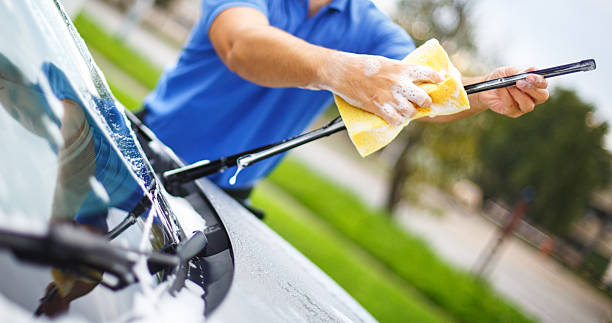If there’s one golden rule when it comes to keeping your windscreen wipers in top shape, it’s this: never use them on a dry windscreen. According to experts, using wipers without washer fluid can lead to faster wear, cause smearing, or even damage the glass surface due to dry friction. Wipers are designed to work in tandem with a proper car screen wash—so always make sure to have some washer fluid in your washer system before turning them on.
In this guide, we’ll walk you through the best practices for looking after your wiper blades from how to clean them properly, to when and how to replace them if needed.
How to Clean Wiper Blades
To extend the lifespan of your wiper blades, it's important to clean them at least once a month, as dirt and grit buildup on the rubber can cause streaking and accelerate wear—both on the blades and your windscreen
What You’ll Need:
-
Sponge, rag, or paper towels
-
Bucket of warm, soapy water
-
Surgical spirit (for streak-free finish)
Note: Never use WD‑40—it leaves greasy film and smears, counterproductive for clean visibility.
Step-by-Step Cleaning
Here’s a simple, effective routine to clean your car’s windscreen wipers and keep them in top shape:
Step 1: Wash your car and windscreen.
Start by cleaning the windscreen using warm, soapy water. Use a sponge or microfiber cloth to remove built-up dirt, then rinse thoroughly with clean water or a hose to clear away loose debris. This gives you a clean surface to work on and prevents dirt from transferring back onto your blades.
Step 2: Lift the wiper arms.
Gently lift each wiper arm away from the windscreen. Most wipers will stay in a raised position on their own. If they don’t, hold them carefully—wiper arms can snap back and damage the glass if dropped.
Step 3: Clean the blades.
Using a clean cloth dipped in warm, soapy water, run it gently along the length of the rubber blade. Wipe from one end to the other, removing any grime, dead insects, or dirt buildup. Be careful not to tug or twist the rubber.
Step 4: Clean the rest of the wiper assembly.
Sometimes streaks aren’t caused by dirty blades, but by the wiper mechanism itself. Use the same soapy water to clean the wiper arms and joints. Dirt or stuck debris can interfere with smooth movement, so make sure everything is clear and moving freely.
Step 5: Finish with surgical spirit.
After washing, give each blade a final wipe with surgical spirit (isopropyl alcohol) using a clean cloth. This removes any lingering soapy residue and helps prevent streaks. Note: Avoid using white spirit as it can degrade the rubber.
Pro Windscreen Wiper Maintenance Tips
To maximise your wiper lifespan and ensure they always perform when needed, keep these expert tips in mind:
Defrost wipers before use.
Your wipers might push away light snow, but they aren’t made to scrape off thick ice. Frozen blades can get stuck to the windscreen, and forcing them on could damage the rubber or even burn out the motor. Always defrost your windscreen using the car’s heater and an ice scraper before activating the wipers.
Clean the blades and windscreen regularly.
Make blade and windscreen cleaning part of your car care routine. Dirt, dust, or road grime can wear the rubber down faster. Regular cleaning with warm, soapy water helps preserve the blades and improve their wiping performance.
Keep your washer fluid topped up.
Wipers rely on washer fluid to clean effectively. Driving with an empty reservoir can lead you to use your wipers dry—causing wear and streaking. Use a high-quality windscreen washer fluid (not just water) to help break down grime and bugs more easily.
Windscreen Wiper FAQs
How can I stop wipers from streaking?
Use warm, soapy water to clean the blades thoroughly. Follow up with surgical spirit to remove any leftover residue. If streaking continues after cleaning, the rubber may be worn or damaged, and the blades might need replacing.
Is WD-40 good for cleaning wiper blades?
No. While WD-40 is a powerful solvent, it’s not suitable for rubber wiper blades. It can cause the rubber to break down or become too slippery, reducing their wiping effectiveness and shortening their lifespan.
Can I use vinegar to clean my blades?
Yes. A 1:1 mix of white vinegar and water can help lift light dirt. Always, finish with surgical spirit to neutralise the vinegar’s acidity and remove any remaining buildup.
Can faulty windscreen wipers cause an MOT fail?
Yes. According to UK MOT guidelines, you can fail if your wipers don’t work properly, are damaged, or are missing entirely. MOT testers will check whether wipers clean the screen effectively and whether the washer system works.
When Should You Replace Wiper Blades?
Watch for these warning signs that it’s time for new blades:
-
Squeaking or juddering during use
-
Skipping or smearing across the windscreen
-
Cracked, brittle, or split rubber
-
Poor performance in rain or frost
Even with proper care, all wipers wear out over time. Experts recommend replacing your blades at least once a year, or sooner if they’re showing any of the signs above.
Final Thoughts on Maintaining Your Wipers
Keeping washer fluid topped up and cleaning your blades regularly is the simplest—and most effective—way to extend the life of your wipers and ensure your windscreen stays clear. Wet surfaces protect rubber and glass; dry rubbing simply damages both.
And don’t forget: make regular blade inspection part of your standard car care routine—your safety depends on it.

